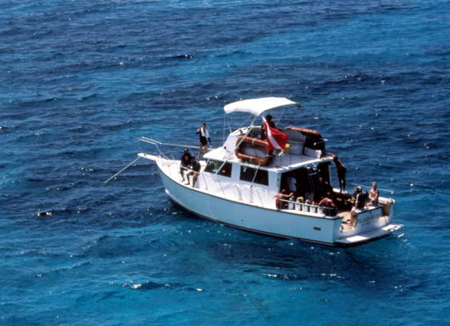
3. Fire It Up equals Electricity
A typical marine diesel engines DC (direct current) electrical systems are a frequent area of concern. Although the electrical system has the least impact for causing detrimental damage to your marine diesel power plant. That doesn’t mean that your electrical components should be ignored. You should be prepared if your electrical system is compromised and decides to quit working properly. Sometimes you’re lucky enough to have your electrical system take a dump at the dock. What happens after a day of fishing when you go to crank the engine up? How about a full boat of divers just getting back on board? Sometimes your marine diesel engine might just quit mid trip while crossing to the Bahamas. No problem just drop the anchor and wait for Sea Tow. Hopefully you have a few extra thousand feet of anchor line. The deepest part of the Atlantic Ocean is 4,580 fathoms; 27,490 ft and is in the Puerto Rico Trench.
What is the main boy scout motto? Be prepared. Seriously you don’t need to go out and purchase thousands of feet of anchor line. But there are a few other commonly replaced items which don’t break the bank. Having backup fuses, common connectors and deep cycle marine batteries is the wisest choice. Improper fittings and connectors are the most frequent violator for DC electrical systems. Checking your fittings and connections is one of the easiest task to do visually. Far and few between on service calls do I see this done appropriately. A little preventative maintenance goes along. Even if you are not experienced enough to do the routine maintenance, at least do a visual inspection. An eyeball diagnosis of your marine diesel engine could save you major headaches down the road. Call Diesel Services of America and we can help fix your issues. That and we will be thoroughly impressed by your pro-active approach. 954-781-1464
The first place to look and the most common breakdown for the electrical system on your marine diesel engine is a basic cable. The cable that runs from your deep cell marine battery to the starter motor is crucial and corrosion is commonplace. Check for acidic buildup at the connections or any fraying of wire that would cause exposure to the elements. Also make sure these end connections are securely fastened and not able to wriggle about easily and become loose. Another frequent perpetrator are the wires from the oil pressure switch. A wrong reading of oil pressure will cause the engine to abruptly shut down. The cooling water temperature switch won’t affect your marine diesel engine as rapidly as the oil pressure switch. But it will still cause the marine diesel engine to not operate at its full capacity. The battery switch might seem basic but again this is subject to the same vibrations and harsh saltwater environments as the rest of your engine room. Fuses mentioned earlier during the duplicate items portion cost a few dollars. Not having extras on board or easily accessible in the engine room is not wise.
More complicated inspection would be looking at the starter motor for a bad solenoid or a malfunctioning Bendix drive. Checking the bolts that keep the alternator firmly in place is not an overly complicated task. Every bolt on your Marine Diesel Engine has a specific torque rating. A crucial element to your Marine Diesel Engine are the belts. Do you have the right size and type of your marine diesel engine? Are the belts properly tight according to torque specifications. An easy to use belt tension jack will make sure the belts are tight to the pulley’s. Call Diesel Services of America and let us help you keep your Marine Diesel Engine running in top ship shape condition.
![]()